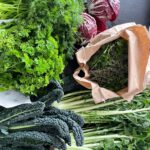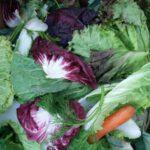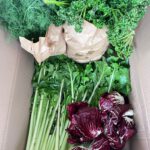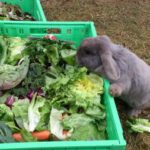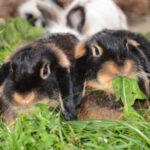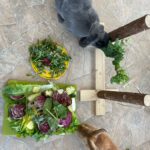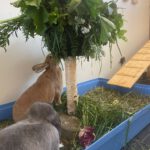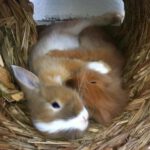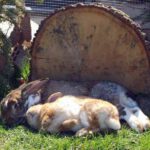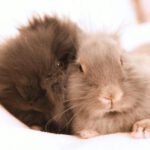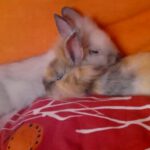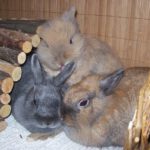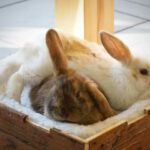Contents
- Properly Feeding Rabbits
- Main Food: Fresh Greens
- Summer Feeding
- Tips:
- Winter Feeding
- What Can My Rabbits Eat?
- How Much Should You Feed Your Rabbits?
- Roughage
- Supplemental Food
- Water
- Food Changes
- Feeding Mistakes?
- Store-Bought Food Mixes Are Unhealthy
- Dental Issues
- Digestive Issues
- Bladder Sludge, Bladder Stones, Kidney Stones & More
- Overweight/Underweight and Related Health Issues
- Behavioral Issues
- Why Is Dry Food Like Pellets, Rabbit Muesli, etc., So Harmful to Dental Health?
- Dried Herbs, Seeds, Pea Flakes & Co.
- Overweight
Properly Feeding Rabbits
Feeding pet rabbits isn’t complicated, but it’s easy to make mistakes that can quickly affect a rabbit’s health.
Rabbits are folivores (leaf-eaters); in the wild, their relatives primarily eat fresh green plant parts, shoots, and leaf tips. They also consume roots and bark as supplements. Because pet rabbits have only recently been domesticated, they still depend on this natural diet.
Main Food: Fresh Greens
Rabbits are fresh-food lovers: the main part of their diet should always consist of fresh, varied greens.
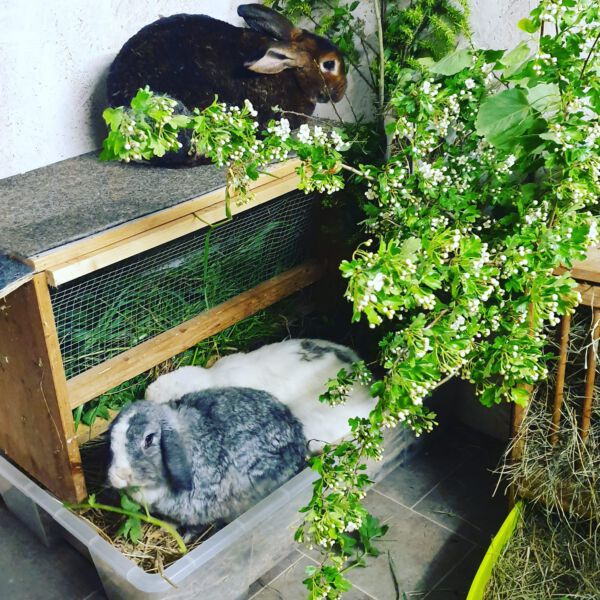
In summer, a diet consisting of grass and twigs is ideal.
Summer Feeding
In spring, summer, and fall, it’s ideal to gather food directly from nature. Meadow plants, branches, and leaves are not only free but also the healthiest food for rabbits.
Outdoor rabbits can also graze their own food, needing only picked greens for nighttime.
The best mix includes two-thirds grasses and one-third mixed meadow herbs.
Sometimes, you can still find wild plants outdoors in winter.

Tips:
- Use a plant identification app (e.g., Flora Incognita) and check edibility with our plant list
- Join plant identification groups (e.g., this one)
- Additional tips
Winter Feeding
If you don’t have access to enough fresh food or can’t find enough in the wild, it’s best to switch to store-bought greens. Ideally, offer at least five different types of fresh greens from different categories every day:
- Bitter greens (endive, radicchio, chicory, sugarloaf, leaf chicory, frisée, dandelion salad…) in large quantities
- Leafy cabbage (kale, savoy cabbage, pointed cabbage, napa cabbage…) about 10% of the diet for indoor rabbits, more for outdoor rabbits
- Vegetable greens (carrot tops, kohlrabi leaves, celery stalks, fennel greens, cauliflower leaves…)
- Herbs (parsley, cilantro, dill – any herbs safe for humans to eat are suitable), <10%
- Green manure (still available on fields until December)
- Twigs <10%
- Add small amounts of other leafy vegetables (other salads, spinach, Swiss chard…)
- Evergreen plants (bamboo…) and any remaining meadow plants.
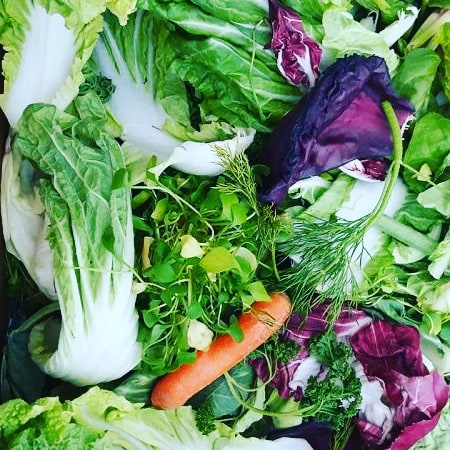
A certain variety is important to ensure that some secondary plant compounds are included, which are crucial for the rabbits‘ health. Rabbits select their food based on their needs.
What Can My Rabbits Eat?
If you’re unsure about what your rabbits can eat, our food lists can help!
Chewing Needs
Rabbits have a strong need to chew, which can be satisfied through constant access to fresh greens. If they are fed highly energetic food, this need is often unfulfilled and may be expressed in destructive behaviors, such as chewing on furniture, fixtures, or carpets.

How Much Should You Feed Your Rabbits?
Many owners make the mistake of feeding unsuitable fresh food (fruit, hard vegetables) as the main part of the diet instead of greens (leafy, herbaceous food). This can lead to digestive issues and dental problems!
Fresh greens must always be available to rabbits, as they take in small amounts throughout the day and night, to keep their digestive system working consistently. You should feed large enough portions so that there are leftovers by the next feeding. Typically, this amounts to about 200-500 grams per kilogram of body weight per day. For two rabbits weighing around 2 kg, this would be about 0.8-2 kg of fresh greens daily. The Veterinary Association for Animal Protection (TVT) recommends 200 grams of fresh food per kilogram of body weight per day for a rabbit. So, a 2 kg rabbit should receive 400 grams of fresh food. However, some rabbits may need a bit more – the amount depends on how much they eat throughout the day and night.
If too little fresh food is provided, so that it doesn’t last until the next feeding, digestive problems can arise. Constant changes from fresh greens to dry food, like hay, can stress the digestive system. Additionally, providing fresh greens consistently is essential for proper tooth wear, as rabbits have continuously growing teeth that can become problematic if not worn down properly.

Roughage
In addition to fresh greens, it is important to consistently offer high-quality hay. Even though rabbits enjoy hay rich in herbs, it’s best to choose one that doesn’t contain too many dry herbs. The hay should be regularly replaced, as toxic plants and other unsuitable parts are often left behind by the rabbits, and the food quality in the enclosure can decrease over time.
Branches (with leaves) are also especially important when primarily feeding leafy vegetables.
Supplemental Food
In addition to the main food, root and tuber vegetables can be offered. However, their portion should be kept to a minimum.
Occasionally, (local) fruit can be fed by hand as a treat, especially in the fall.
Water
Fresh water is best offered in a stable ceramic bowl. To prevent contamination, it is most effective to place the bowl elevated or on a surface without bedding. Nipple drinkers are not suitable as the sole water source.
Food Changes
Diet changes should always be done gradually. New food types must first be tested in small amounts for tolerance. If you want to change the diet, double the amount of the new food each day while halving the amount of the old food.
Feeding Mistakes?
There are some common mistakes that are widespread and can negatively affect the health of our rabbits.

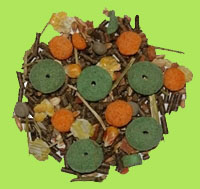
Store-Bought Food Mixes Are Unhealthy
Feeding rabbits store-bought food mixes can make them sick over time. Artificial flavors and high energy content (carbohydrates, fats, and proteins) affect their sense of taste, causing them to consume these low-quality ingredients. Dry food is unnatural and harms the entire rabbit’s system! The consequences are often a range of illnesses (such as diarrhea, dental problems, bladder sludge, and bloating), leading to high veterinary costs.
The list of secondary diseases caused or worsened by a dry food diet is long.
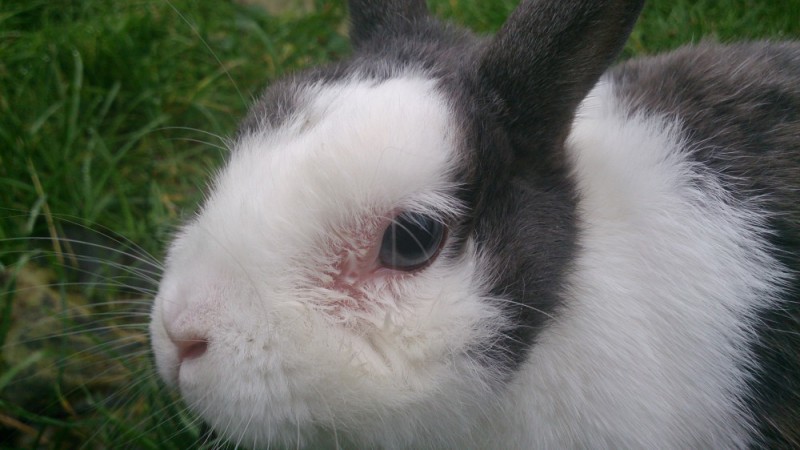
Dental Issues
Only 20% of dental problems in rabbits can be seen with a careful look inside the mouth, while the remaining 80% can only be detected through a mouth examination under anesthesia and multiple X-rays of the head from different angles, along with appropriate evaluation. Tooth root diseases are a common consequence of feeding dry food and become visible in advanced stages through symptoms like watery eyes, abscesses, or nasal discharge (often mistaken for a cold by non-rabbit-savvy veterinarians!).
Intolerances to large amounts of fresh food or fresh food in general are also typical signs of dental issues! Dry food makes rabbits feel full faster (even small amounts, like one tablespoon a day, can result in them eating less than half of the required greens!). This means that their ever-growing teeth no longer wear down. Due to the high degree of processing (food powders instead of fibers), dry food is barely chewed. Furthermore, rabbits chew dry food differently than their natural diet: dry food is „cracked“ (which puts high pressure on the jaw and tooth roots, leading to retrograde tooth growth), while fresh greens are ground down.
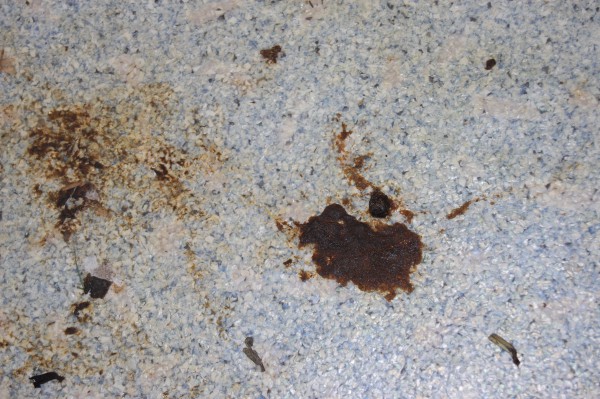
Digestive Issues
Many rabbits eventually develop diarrhea from fresh food or can no longer tolerate certain foods! „Occasional diarrhea“ or an overproduction of cecotropes is a common result of feeding dry food. Some rabbits are also prone to constipation, bloating, and gastric dilatation. There are several reasons for this:
First, rabbits need very coarse food to stimulate their digestive system due to their poorly developed peristalsis. Coarse food helps improve gut transit. Dry food, however, is finely ground and made from food powders, which slow down the metabolism.
Second, rabbits have a very specific bacterial flora in their digestive tract. Feeding dry food nourishes harmful bacteria, which can spread and overtake the healthy gut flora.
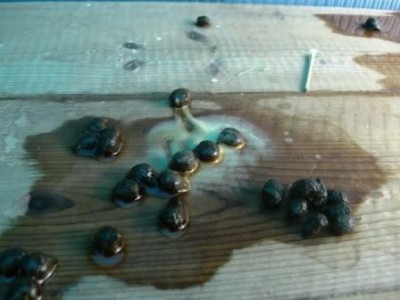
Bladder Sludge, Bladder Stones, Kidney Stones & More
Feeding dry food results in rabbits eating significantly less fresh food. Even less than one tablespoon per rabbit per day reduces the fresh food intake so drastically that they consume less than half the required amount of greens. The lack of water in the food cannot be compensated by drinking, and there are comprehensive studies on this! As a result, the urinary tract is insufficiently flushed.
Rabbits do not absorb calcium based on their needs but rather in the amount they take in. Due to their unique calcium metabolism, when water intake is reduced, calcium can quickly accumulate in the kidneys or bladder, as the urine becomes more concentrated. Additionally, artificially added vitamin D in dry food can trigger deposits in the urinary tract.
Overweight/Underweight and Related Health Issues
The energy content of these foods is very high, which can lead to obesity, organ damage (often accompanied by weight loss), and related health problems. This can result in joint diseases (as the excess weight puts stress on the bones), digestive issues (as the organs are displaced by fat), and bladder sludge (as the animals move less, leading to easier deposition of urinary crystals).
Rabbits fed dry food tend to become much quieter and more „lazy,“ and there are various reasons for this. Firstly, the food burdens the digestion, as it is completely unnatural and unsuitable. As a result, it sits heavily in the stomach. Secondly, their metabolism is altered. With dry food, a „dry metabolism“ is triggered, causing the animals to conserve energy and become very inactive. Due to the high energy density, they become full quickly and do not need to work for their food, nor are they busy with foraging or food-related activities.
Behavioral Issues
Due to the higher energy content, rabbits become full quickly, spending only a tenth of their time eating. A freshly fed rabbit typically spends 80% of its activity phases eating. As a result, various behavioral problems can arise from boredom, such as chewing on the cage bars, pulling out fur, or excessive licking of wounds.
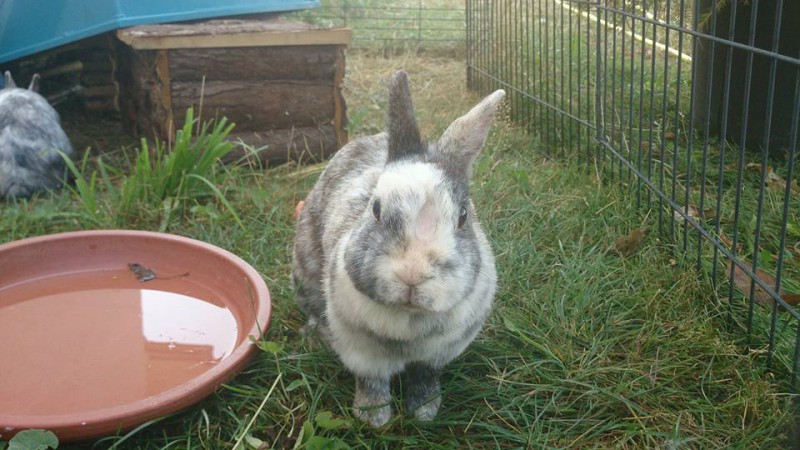
Commercial dry food mixes are formulated for the increased nutritional needs of breeding and fattening animals, which do not live long. As the sole food for pet rabbits, which are meant to live up to 10 years, these mixes are too low in fiber and too high in energy and calcium. When fed continuously, they lead to:
- Reduced tooth wear
- Obesity
- Dysbiosis
- Uroliths/Calcium deposits
- Diarrhea
To prevent long-term damage in pet rabbits, they should be transitioned to a physiologically appropriate fresh diet as soon as possible after acquisition.
— Dr. med. vet. Hein – One of the leading rabbit specialists in Germany. Specialization in Companion Animals/Small Mammals, Diplomate ECZM (Small Mammal).

Why Is Dry Food Like Pellets, Rabbit Muesli, etc., So Harmful to Dental Health?
In the graphic, you can see that rabbits chew pellets in the same way we do—they bite down on the pellet and „crack“ it. This creates significant pressure on the teeth in the jaw, which at the very bottom contain the sensitive germ center, where new tooth material is formed. Unlike other animals or humans, rabbits‘ teeth grow continuously, and therefore, they are not as firmly anchored in the jaw. They need to be pushed upward to grow. Over time, the pressure from biting down on pellets causes the tooth to be pushed deeper into the jaw, eventually leading to the tooth piercing through the bone, resulting in watery eyes and abscesses in the jaw or behind the eye.
With natural food, rabbits grind their food rather than biting into it. The surface of their teeth has edges that, like a grater, slice the food.

Dried Herbs, Seeds, Pea Flakes & Co.
The market offers various natural treats that encourage pampering rabbits. After all, everything is natural! But beware, even these seemingly „healthy“ snacks can be harmful to their health. They should really only be given in very small amounts by hand, such as half a teaspoon of dried herbs twice a week in an enrichment toy, or half a pea flake once a week as a treat during weighing. I personally prefer to use Cuni Complete as a treat: While it is just as unhealthy as other treats, if you moisten it, it becomes harmless for the teeth, and it can also be used to hide medications (see medication administration). It is especially useful for rabbits with dental issues or after dental surgeries when chewing still causes pain. This way, the rabbits are already familiar with it for such situations.
Overweight
Rabbits are prone to becoming overweight, especially in indoor housing, but also with an overly rich or improper diet. If rabbits gain weight, the energy content of their food should be reduced.
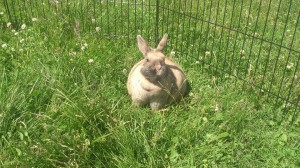
Sources, including:
Abgarowicz, F. (1948): Untersuchungen über den Einfluß des Ballastes in der Nahrung des Kaninchens; Eidgen. Tech. Hochschule Zürich
AGRARForschung (2006): Einfluss der Konservierung auf den Aminosäurengehalt des Futters. 2006
Ahluwali, B./Pincus, G./Holman, R. T.: Essential Fatty Acid Deficiency and Its Effects upon Reproductive Organs of Male Rabbits.
Arbeitsgemeinschaft für Wirkstoffe in der Tierernährung e.V. (Hrsg.): Aminosäuren in der Tierernährung. Bonn: Agrimedia GmbH, 1998
Arbeitsgemeinschaft für Wirkstoffe in der Tierernährung e.V. (Hrsg.): Enzyme in der Tierernährung. Bonn: Agrimedia GmbH, 2004
Arbeitsgemeinschaft für Wirkstoffe in der Tierernährung e.V. (Hrsg.): Probiotika in der Tierernährung. Bonn: Agrimedia GmbH, 1999
Arbeitsgemeinschaft für Wirkstoffe in der Tierernährung e.V. (Hrsg.): Vitamine in der Tierernährung. Bonn: Agrimedia GmbH, 2001
Asghar, A./Pearson, A. M./Magee, W. T./Tahir, M. A.: Effects of Ad Libitum, Maintenance and Sub-Maintenance Feeding and of Compensatory Growth on Some Biochemical Properties of Muscle from Weanling Rabbits.
Bieber, A./ Seidel, K./ Wyss, G.S./ Maurer, V./ Zeltner, E.: Einfluss von Diäten aus konventioneller und biologischer Erzeugung auf Fruchtbarkeitsparameter bei Kaninchen, 2009
Boback, A. W.: Das Wildkaninchen. Wittenberg Lutherstadt: A. Ziemsen Verlag, 1970
Böhmer, E. (2011): Zahnheilkunde bei Kaninchen und Nagern: Lehrbuch und Atlas; mit 27 Tabellen. Schattauer.
Böhmer, E. (2014): Warum leiden Hauskaninchen so häufig an Gebiss-und Verdauungsproblemen. Ein Ratgeber für die Ernährung von Kaninchen, 248.
Cheeke, P.R.: Rabbit feeding and nutrition. Animal feeding and nutrition. A series of monographs. Academic Press, London, 1987
Chrastinová, L./Chrenková, M./Lauková, A./Rafay, J./Simonová, M./Vasilková, Z./Szabóová, R./Strompfová, V./Ondruska, L./Faix, S./Plachá, I.: Effect of dietary herbal extracts on health and performance of rabbits.; 2007
Czitrich, O.: Nahrungsergänzungsmittel. Sinnvoll oder gefährlich? Wissenschaftlicher Aufsatz. Books on Demand, 2006
Czitrich, O.: Vorsicht vor Vitaminen. Wissenschaftlicher Aufsatz. Books on Demand, 2005
Dillitzer, N.: Ernährungsberatung in der Kleintierpraxis: Hund, Katze, Reptilien, Meerschweinchen, Kaninchen. Urban&Fischer, 2009
Eickhoff, M.: Zahn-, Mund- und Kieferheilkunde bei Klein- und Heimtieren. Stuttgart: Enke-Verlag, 2005
Engel, C.: Wild Health. Gesundheit aus der Wildnis. Wie Tiere sich selbst gesund erhalten und was wir von ihnen lernen können. Bernau: animal learn Verlag, 2004
Ewringmann, A. (2005). Leitsymptome beim Kaninchen: diagnostischer Leitfaden und Therapie; 33 Tabellen. Georg Thieme Verlag.
Fatrai, A./Krokowski, C (2007): Akupunktur und Phytotherapie bei Kaninchen und Meerschweinchen. Sonntag Verlag
Gadsch, W.: Die zeitgemäße Kaninchenfütterung. Eine zeitgemäße Betrachtung zur Frage der Kaninchenfütterung unter besonderer Berücksichtigung der wirtschaftlichen und volkswirtschaftlichen Forderungen mit dem Ziele der Leistungssteigerung. Berlin: Verlag für Tierzucht und Landwirtschaft, 1942
Hand, M. S.: Klinische Diätetik für Kleintiere. Schlütersche; Auflage: 4., erw. u. vollst. neubearb. Aufl. 2003
Hein, J. (2016): Durchfall beim Kaninchen–Ursachen und Therapie. kleintier konkret, 19(S 01), 2-9.
Kamphues, J./Coenen, M./Kienzle, E./ Pallauf, J./ Simon, O./ Zentek, J.: Supplemente zu Vorlesungen und Übungen in der Tierernährung. 10., überarb. Auflage. M&H Schaper Verlag, 2004
Kamphues, J.: Kaninchen und Meerschweinchen: Häufige Fütterungsfehler und Hinweise zur Diätetik
Kariger, A.: Die Entwicklung der Mischfutterindustrie in Deutschland. Stuttgart: Kohlhammer Verlag, 1963
Kirchgeßner, M.: Tierernährung. Leitfaden für Studium, Beratung und Praxis. 6., verbesserte Auflage, Frankfurt (Main): DLG-Verlag, 1985
Krüger, M.: Mikroflora des Verdauungskanals bei kleinen Heimtieren – Besonderheiten und Unterschiede
Lackenbauer, W.: Kaninchenfütterung. Artgerecht. naturnah. wirtschaftlich. Reutlingen: Oertler+Spörer Verlag, 2001 Linder, H.: Allgemeine Biologie. Stuttgart
Mangold, E./Fangauf R.: Handbuch der Kaninchenfütterung. Berlin: Neumann Verlag, 1949
Nachtsheim, H.: Vom Wildtier zum Haustier. 2. verbesserte und vermehrte Auflage, Paul Parey Verlag, Berlin 1949
Nehring, K.: Lehrbuch der Tierernährung und Futtermittelkunde. 7. Auflage. Neumann Verlag, 1959
Pfaffl, M. W.: Effekte von sekundären Pflanzenstoffen auf die Darm-Morphologie und das Immunsystem von Monogastriern.; 2007
Schley, P.: Kaninchen. Ulmer. Stuttgart 1985
Schlolaut, W.: Das große Buch vom Kaninchen. 3. überarb. Auflage. DLG-Verlag GmBH, 2003
Schwabe, K.: Futter- und Wasseraufnahme von Heimtieren verschiedener Spezies (Kaninchen, Meerschweinchen, Chinchilla, Hamster) bei unterschiedlicher Art des Wasserangebotes, Tierärztl. Hochschule Hannover, 1959Schweigart, G.: Zahnfehlstellungen bei Nagetieren und Kaninchen, 1998
Sebesteny, A.: Acute obstruction of the duodenum of a rabbit following the apparently successful treatment of a hairball, Laboratary Animals, 1977
Wenger, A.: Vergleichende Untersuchungen zur Aufnahme und Verdaulichkeit verschiedener rohfaserreicher Rationen und Futtermittel bei Zwergkaninchen, Meerschweinchen und Chinchilla, Hannover, Tierärztl. Hochschule, 1997
Wiesenmüller, W./Leibestseder J.: Ernährung monogastischer Nutztiere. Gustav Fischer Verlag Jena, 1993
Wilde, C.: Kaninchen Info; http://www.die-kaninchen-info.de
Wolf, P./Bucher, L./Zumbrock, B./Kamphues, J.: Zur Wasseraufnahme bei Kleinsäugern.
Wolf, P./Buchner, L./Zumbrock, B./Kamphus, J.: Untersuchungen zur Wasseraufnahme von Kaninchen, Meerschweinchen und Chinchillas als Heimtiere Grunddaten und Einflussfaktoren.
Wolf, P./Kamphues J.: Kritische Einschätzung kommerzieller Ergänzungspräparate für Kaninchen, Meerschweinchen und Chinchilla, 2003
Wu, Y.: Ernährungstherapie mit chinesischen Kräutern. Die chinesische Diätetik kombiniert mit Phytotherapie. Urban&Fischer, 2005
Zentec, J.: Workshop VI – Die Belange des Tieres I. Kongress Mensch und Tier – Tiere in Prävention und Therapie, 2007
Zentek, J./Hellweg, A./Khol-Parisini, A.: Spurenelemente als Faktoren der Tiergesundheit, 2007
Zumbrock, B: Untersuchungen zu möglichen Einflüssen der Rasse auf die Futteraufnahme und –verdaulichkeit, Größe und Füllung des Magen-Darm-Traktes sowie zur Chymusqualität bei Kaninchen (Deutsche Riesen, Neuseeländer und Zwergkaninchen); Tierärztliche Hochschule Hannover




